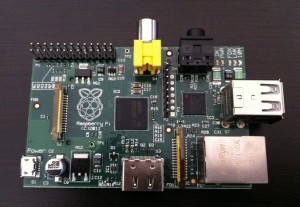Finally, after many months of wait, I have received my brand new toy 🙂

Raspberry Pi it’s on my desk!
I want to build a little media-center around this board (Raspberry Pi Model B), a very small and silent device with 1080p capabilities.
To build this multimedia device, I need, of course, some stuff:
- since I have to use a DVI monitor, and the Raspberry Pi has only HDMI output, I need a HDMI-DVI cable
- a micro USB power supply 1000mA at 5V (better 2000mA)
- SD card >= 2GB
- USB keyboard and mouse
- Ethernet cable for Internet connection
- composite cable (optional)
- some powered USB hub (optional)
I will try to run on Raspberry Pi Raspbmc and OpenELEC.
Notes about first tests and accessories used:
- the micro USB power supply must be at least 750mA-1000mA but if want to plug an USB keyboard on the Raspberry Pi when running something like XMBC you can experience system freezes/crashes. So if you want to test the Raspberry Pi without a powered USB hub with XBMC and keyboard and mouse i suggest to use a micro USB power supply capable of 1500mA or 2000mA.
- the micro USB power supply, if not good enough, can generate some really annoying noise on audio analog output, so try some others power supply until you find the good one (for example the iPhone’s power supply works like a charm).
- DVI monitor can by difficult to setup with Raspberry Pi, so if you can, use a TV/monitor with HDMI input (I will explain later how to deal with it…)
- I have tested this hardware with SD from Samsung and Kentron, 2GB and 8GB, with and without MicroSD adapter. Class 4, 6 and 10. No compatibility problems at all.
- I have found a cheap HDMI-to-DVI cable (brand VulTech, model DHM02) on ebay working fine. Keep it on mind before buying some expensive cables from local resellers (they can cost up to 50/100 Eur)
- as I have understood, HDMI and DVI are pin to pin compatibles (except the audio part), so any HDMI-to-DVI cable can works in both ways.
- try to use the Ethernet connection instead a wireless dongle at the beginning. Every piece of hardware added can compromise the stability of the “contraption” 🙂 so remember: KISS rules!
0 Comments